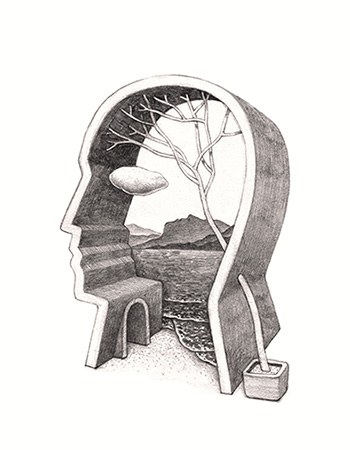Featured
The Bad-Behavior Blend
Scientists explore the interplay of genes, environment, and antisocial behavior

- By scouring the entire human genome, psychologists and other scientists have discovered an array of genetic markers for incivility, immorality, and lawlessness.
- Scientists are also examining how parenting, education, and other life experiences trigger those biological leanings.
- Behavioral genetics researchers hope their findings could lead to parenting and educational interventions for people who face innate risks for antisocial behavior.
The evolution of behavioral genetics • Emotional markers • Expanding the pool
Anthony Blas Yepez is one of the latest high-profile murderers to blame his crimes on his genes.
In 2015, a jury in Santa Fe, New Mexico, convicted Yepez in the brutal killing of his girlfriend’s step-grandfather during a domestic fight and sentenced him to 22 years in prison. In the trial, the judge barred Yepez’s public defender from introducing evidence that pointed to his history of childhood abuse and his so-called genetic vulnerability to violent impulses. His appeals climbed to the New Mexico Supreme Court, which rejected the argument in 2021.
Yepez’s case followed similar defense arguments in murder cases in Europe and the United States. But studies suggest the use of behavioral genetics in criminal defense strategies is holding little sway among judges and juries, as indicated by convictions and sentences (Scurich & Appelbaum, 2017).

The meager influence on criminal proceedings reflects the complexities and nuances that have emerged in the field of behavioral genetics. Scientists have long agreed—and the courts and general public increasingly understand—that genes are only an ingredient, not a solitary cause, of deviant behavior and psychopathology. Life outcomes involve experiences as much as biology, although experts debate which has the larger influence. In his controversial 2018 book Blueprint: How DNA Makes Us Who We Are, APS William James Fellow Robert Plomin asserted that genetic factors outweigh upbringing in our life trajectory (Plomin, 2018). Other researchers, such as APS Fellow Marinus van IJzendoorn at Leiden University in the Netherlands, have described the search for genetic ties to behavior problems as “a search for needles in a haystack” (Cole, 2015).
Related: See Robert Plomin’s 2004-2005 APS William James Fellow Award address.
Earlier research focused on tying singular genes to specific psychological differences. But over the past two decades, psychologists and other scientists have scoured the entire human genome and instead discovered an array of genetic markers for psychological traits and behaviors.
“The one gene, one disease idea is a thing of the past,” APS Fellow Terrie Moffitt of Duke University said in an interview.
Behavioral genetics research has included a search for the intricate roots of antisocial behaviors ranging from impulsivity to violence. Scientists aren’t simply trying to identify people who are innately predisposed to incivility, immorality, or lawlessness. They’re examining how parenting, education, and other life experiences trigger those biological leanings.
More research on aggression and violence
-

Back Page: Environment and Disinhibition
Arielle Baskin-Sommers explores the cognitive-affective processes associated with disinhibition and community violence.
-

Psychosis and Violence Aren’t Strongly Linked
Violent individuals are often assumed to suffer from a long history of mental illness that compels them to act destructively, but the link between psychosis and aggressive acts may be weak.
-

Science Reveals a Silver Lining to Dark Behaviors
For psychological scientists, exploring the less pleasant aspects of individual and social nature is an occasional necessity.
The evolution of behavioral genetics
The exploration of biological links to behavioral problems advanced in 1993 when Dutch geneticist Han Brunner and colleagues pinpointed a potential connection between violence and a defect in the monoamine oxidase A (MAOA) gene. MAOA is an enzyme that helps regulate brain function (Brunner et al., 1993). Since then, MAOA variants have been linked to depression, antisocial behavior, and violent crime. Yepez’s lawyers argued that he has an MAOA variant known as the “warrior gene” that left him unable to control his violent impulses.
Moffitt and psychological scientist Avshalom Caspi were among the first researchers to uncover a nurture element to the MAOA influence. In a widely cited longitudinal study, the Duke researchers examined data from a large birth cohort in Dunedin, New Zealand, and found that males who were prone to MAOA deficiencies were most likely to become violent adults if they were also mistreated as children (Caspi, et al., 2002), whereas males with high levels of the enzyme showed no measurable antisocial tendencies, even if they had suffered abuse or neglect in childhood. Neither genes nor environment worked in isolation to spur violent tendencies.
Navigating the Ethical Challenges of Aggression Research
As scientists investigate genetic factors associated with aggression—one of the most palpable forms of antisocial behavior—they face a new array of ethical challenges.
Examining how the mix of biology and environment contributes to aggression raises new challenges with informed consent, confidentiality, and data management. And public misinterpretations of findings could fuel racial bias, psychological scientist and ethicist Celia Fisher of Fordham University said at a National Institutes of Health (NIH) workshop in June. Reports of genetic markers for aggression may underestimate the influence of poverty and racism that play an equal if not larger role in antisocial behavior.
“Aggression science is not conducted in a sociopolitical vacuum,” Fisher said. “Use of research results may produce disadvantageous policies to marginalized populations … and data may unintentionally nurture the public tendency toward group stigmatization or genetic essentialism.”
Fisher was among a host of psychologists, biologists, geneticists, and other scientists participating in the NIH workshop, “Advancing the science of aggression across species and disciplines.” NIH assembled the scientists to discuss how aggression research can lead to better prevention programs, assessments, and treatment.
Many of the investigations are conducted with children and adolescents, as scientists try to spot early biological and environmental factors of aggression. But what findings should researchers share with parents? When are they obligated (or legally bound) to report a study participant’s victimization or dangerous intentions?
“This raises what’s been called the scientist–citizen dilemma,” Fisher said. “Do scientists have a citizen’s obligation to help those they know are in jeopardy? Alternatively, does the fact that we as researchers are producing socially valuable data mean that the investigator role supersedes such citizen obligations?”
Scientists can address these concerns through evidence-based disclosure and reporting policies that build, rather than hamper, trust with participants and the public, Fisher asserted. She offered several suggestions, including improving informed consent procedures so that participants and their families fully understand when and with whom information will be shared.
Scientists also must agree on circumstances in which genetic information is shared with parents and should recruit qualified genetic counselors who can help minimize misconceptions, Fisher said. Parents are increasingly requesting access to their children’s genomic data and can easily misinterpret that information, she explained. A parent may, for example, mistakenly conclude their child has a genotype that’s fully responsible for bad behavior.
Disclosure policies must also account for cultural and systemic influences on aggressive behaviors, workshop participants agreed. And assessment instruments should be validated for use with the racial and ethnic composition of the research samples, Fisher said.
“We also have to avoid analyzing racial factors as implied biological markers for genotypes associated with aggression,” she added.
Aggression involves a constellation of biological, social, and cognitive risk factors that affect a small percentage of children and adults, many of whom have underlying psychological disorders that can be treated, said APS Fellow Abigail Marsh, director of the Laboratory on Social and Affective Neuroscience at Georgetown University.
“One of the central problems with studying aggression is that people with these disorders are hard to sympathize with sometimes,” she said. “But we need to. Nobody chooses to have the risk factors for aggression. I think improving public health requires getting better at identifying people who are at high risk for aggression and connecting them with treatments we know are effective, as well as developing even better treatments in the future.”
Other psychological researchers participating in the workshop included APS Fellows Terrie Moffitt of Duke University and behavioral geneticist S. Alexandra Burt of Michigan State University, as well as developmental psychologist Spencer Evans of University of Miami. An archived video of the online workshop is available at https://obssr.od.nih.gov/news-and-events/events/advancing-science-aggression-across-species-and-disciplines.
In recent years, the study of gene–behavior associations has grown more multifaceted. Part of that work has involved the use of polygenic scores, which are probabilistic measures of an individual’s genetic propensity for certain traits and life trajectories.
“Polygenic scores follow the age-old aggregation principle in psychology,” Moffitt explained. “You don’t have just one measurement. You want to have multiple measurements, which is a more reliable approach to ascertaining risks.”
Criminal activity is an obvious form of antisocial behavior, and researchers in recent years have discovered some genetic associations with crime. Some of those findings emanate from the Broad Antisocial Behavior Consortium (BroadABC), an international initiative aimed at detecting genetic variants linked to social deviance. BroadABC has access to data from 25,891 individuals across eight samples. Among the scientists involved in the consortium are psychological scientists Danielle Dick of Rutgers University and APS Fellow S. Alexandra Burt of Michigan State University. Since it launched in 2013, BroadABC has analyzed polygenic scores and identified heritable traits associated with antisocial behavior, including criminal activity (Tielbeek et al., 2017, 2022).
Research has also identified the environmental influences that mix with genetic risk for unlawful behavior. In one study, Moffitt and Caspi joined University of Edinburgh developmental psychologist Jasmin Wertz and colleagues in analyzing police records and data from both the Dunedin pool and the E-Risk Longitudinal Twin Study in the United Kingdom.
They found that people low in polygenic scores for educational achievement had a slightly heightened rate of criminal offenses as adults, a risk that remained after controlling for socioeconomic status and any antisocial behavior among their parents. The genetic risks emerged during primary school, manifested by low cognitive abilities and self-control, academic difficulties, and truancy.
The findings in no way establish genes as destiny, the scientists cautioned. Many children who carry low levels of the gene variants associated with educational achievement finish school and obey the law. The findings suggest, however, that improving children’s school experiences might help counteract their genetic risks for crime (Wertz, 2018).
In one of the largest genome-wide association studies ever conducted, an international team of psychologists and other researchers identified 579 locations in the genome associated with susceptibility to child behavior problems, addiction, and other self-regulation deficits. The scientists analyzed data from more than 65 studies, yielding a sample size of 1.5 million people. They identified locations on the genome that were associated with self-regulation problems then summed them [the locations] for each participant to derive their personal polygenic self-regulation score. The findings illuminate the biological components of behavioral disorders, the team wrote.
The scientists cautioned that the sample involved only people of European ancestry and added that the results are not evidence that antisocial behavior is innate (Karlsson Linnér et al., 2021).
“Instead, genes influence the way our brains develop, which can make us more at risk for certain outcomes,” Dick wrote in an email. “In this case, we find that there are genes that broadly influence self-control or impulsivity, and that this predisposition then confers risk for a variety of life outcomes.”
Emotional markers
Scientists have also employed a statistical method called quantitative genetic modeling to identify gene–behavior associations. This approach focuses more on observable traits while summarizing the underlying genetic and environmental influences. Among the leaders in this line of research are APS Fellow Jennifer L. Tackett of Northwestern University, Frank Mann at Stony Brook University, and Kathryn Paige Harden and Elliott Tucker-Drob at the University of Texas at Austin. The researchers have tapped data from the Texas Twin Project, a longitudinal lab investigation directed by Harden and Tucker-Drob that tests adolescent identical and fraternal twin pairs and multiples using cognitive assessments, surveys, and behavioral tasks.
In a study published in Clinical Psychological Science in 2018, Mann, Harden, Tucker-Drob, and Tackett found a gene–environment interaction connected to conduct problems in children with high callous-unemotional (CU) traits, a cluster of emotional markers that include a lack of remorse and regard for others. Using a battery of questionnaires, the scientists asked the respondents to rate their sensitivity to others’ feelings and their concern about doing things well (designed to assess the presence of CU traits) as well as their behaviors such as aggression, stealing, and alcohol use. They compared similarities between identical twins and fraternal twins to estimate genetic influences. Such comparisons can pin down heritability since identical twins, unlike fraternal twins, share the same genome. The researchers found that CU traits amplified genetic influences on aggressive behavior and rule breaking. They also found that environmental influences (e.g., peers, shared home environment) trumped genetic factors in influencing rule-breaking behavior specifically.
“In sum, there appears to be a strong social component that may be unique to rule-breaking expressions of antisocial behavior,” the researchers reported (Mann, et al., 2018).
Expanding the pool
Behavioral genetics research faces some weaknesses, Dick pointed out. The field suffers from a profound lack of diversity, she wrote in a recent article for Current Directions in Psychological Science. Nearly 80% of gene-identification studies center on individuals of European descent, leaving out historically disadvantaged populations and their specific gene–environment interactions. Researchers are stepping up efforts to increase diversity in samples but will need time and substantial investment to correct the imbalance, she wrote (Dick, 2022).
Behavioral genetics is far from ready for clinical applications, Dick has said, but she has called on researchers to prioritize public education to help people interpret their genetic risk scores for various medical and psychological problems. (Her 2021 book The Child Code: Understanding Your Child’s Unique Nature for Happier, More Effective Parenting is part of her contribution to that effort.) Parents, for example, should understand how their child’s genetic code influences their behavior and how they can adapt their parenting strategies to the child’s distinctive needs, she has written.
“We should be able to harness the wealth of new genetic knowledge to improve lives,” she wrote in the Current Directions article, “but it will require educating the public [and likely many medical professionals] about the complex ways that genes influence behavior, alongside the environment.”
Feedback on this article? Email [email protected] or login to comment. Interested in writing for us? Read our contributor guidelines.
Brunner, H. G., Nelen, M., Breakefield, X. O., Ropers, H. H., & Van Oost, B. A. (1993). Abnormal behavior associated with a point mutation in the structural gene for monoamine oxidase A. Science, 262(5133), 578–580. https://doi.org/10.1126/science.8211186
Caspi, A., McClay, J., Moffitt, T. E., Mill, J., Martin, J., Craig, I. W., Taylor, A., & Poulton, R. (2002). Role of genotype in the cycle of violence in maltreated children. Science, 297(5582), 851–854. https://doi.org/10.1126/science.1072290
Cole, C. (2015). Passing down psychopathology. Observer, 28(8). https://www.psychologicalscience.org/observer/passing-down-psychopathology
Dick, D. M. (2021). The child code: Understanding your child’s unique nature for happier, more effective parenting. Avery.
Dick, D. M. (2022). The promise and peril of genetics. Current Directions in Psychological Science, 31(6), 480–485. https://doi.org/10.1177/09637214221112041
Karlsson Linnér, R., Mallard, T. T., Barr, P. B., Sanchez-Roige, S., Madole, J. W., Driver, M. N., Poore, H. E., de Vlaming, R., Grotzinger, A. D., Tielbeek, J. J., Johnson, E. C., Liu, M., Rosenthal, S. B., Ideker, T., Zhou, H., Kember, R. L., Pasman, J. A., Verweij, K. J. H., Liu, D. J., … Dick, D. M. (2021). Multivariate analysis of 1.5 million people identifies genetic associations with traits related to self-regulation and addiction. Nature Neuroscience, 24, 1367–1376. https://doi.org/10.1038/s41593-021-00908-3
Mann, F. D., Tackett, J. L., Tucker-Drob, E. M., & Harden, K. P. (2018). Callous-unemotional traits moderate genetic and environmental influences on rule-breaking and aggression: Evidence for gene × trait Interaction. Clinical Psychological Science, 6(1), 123–133. https://doi.org/10.1177/2167702617730889
Plomin, R. (2018). Blueprint: How DNA makes us who we are. MIT Press.
Scurich, N., & Appelbaum, P. S. (2017). Nature Human Behaviour, 1(11), 772–774. https://doi.org/10.1038/s41562-017-0212-4
Tielbeek, J. J., Johansson, A., Polderman, T. J. C., Rautiainen, M. R., Jansen, P., Taylor, M., Xiaoret, T., Lu, Q., Burt, A. S., Tiemeier, H., Vidding, E., Plomin, R., Martin, N. G., Heath, A. C., Madden, P. A. F., Montgomery, G., Beaver, K. M., Waldman, I., Gelernter, J., … Posthuma, D. (2017). Genome-wide association studies of a broad spectrum of antisocial Behavior. JAMA Psychiatry, 74(12), 1242–1250. https://doi.org/10.1001/jamapsychiatry.2017.3069
Tielbeek, J. J., Uffelmann, E., Williams, B. S., Colodro-Conde, L., Gagnon, É., Mallard, T. T., Levitt, B. E., Jansen, P. R., Johansson, A., Sallis, H. M., Pistis, G., Saunders, G. R. B., Allegrini, A. G., Rimfeld, K., Konte, B., Klein, M., Hartmann, A. M., Salvatore, J. E., Nolte, I. M., … Posthuma, D. (2022). Uncovering the genetic architecture of broad antisocial behavior through a genome-wide association study meta-analysis. Molecular Psychiatry, 27(11), 4453–4463.
https://doi.org/ 10.1038/s41380-022-01793-3
Wertz, J., Caspi, A., Belsky, D. W., Beckley, A. L., Arseneault, L., Barnes, J. C., Corcoran, D. L., Hogan, S., Houts, R. M., Morgan, N., Odgers, C. L., Prinz, J. A., Sugden, K., Williams, B. S., Poulton, R., & Moffitt, T. E. (2018). Genetics and crime: Integrating new genomic discoveries into psychological research about antisocial behavior. Psychological Science, 29(5), 791–803. https://doi.org/10.1177/0956797617744542





APS regularly opens certain online articles for discussion on our website. Effective February 2021, you must be a logged-in APS member to post comments. By posting a comment, you agree to our Community Guidelines and the display of your profile information, including your name and affiliation. Any opinions, findings, conclusions, or recommendations present in article comments are those of the writers and do not necessarily reflect the views of APS or the article’s author. For more information, please see our Community Guidelines.
Please login with your APS account to comment.